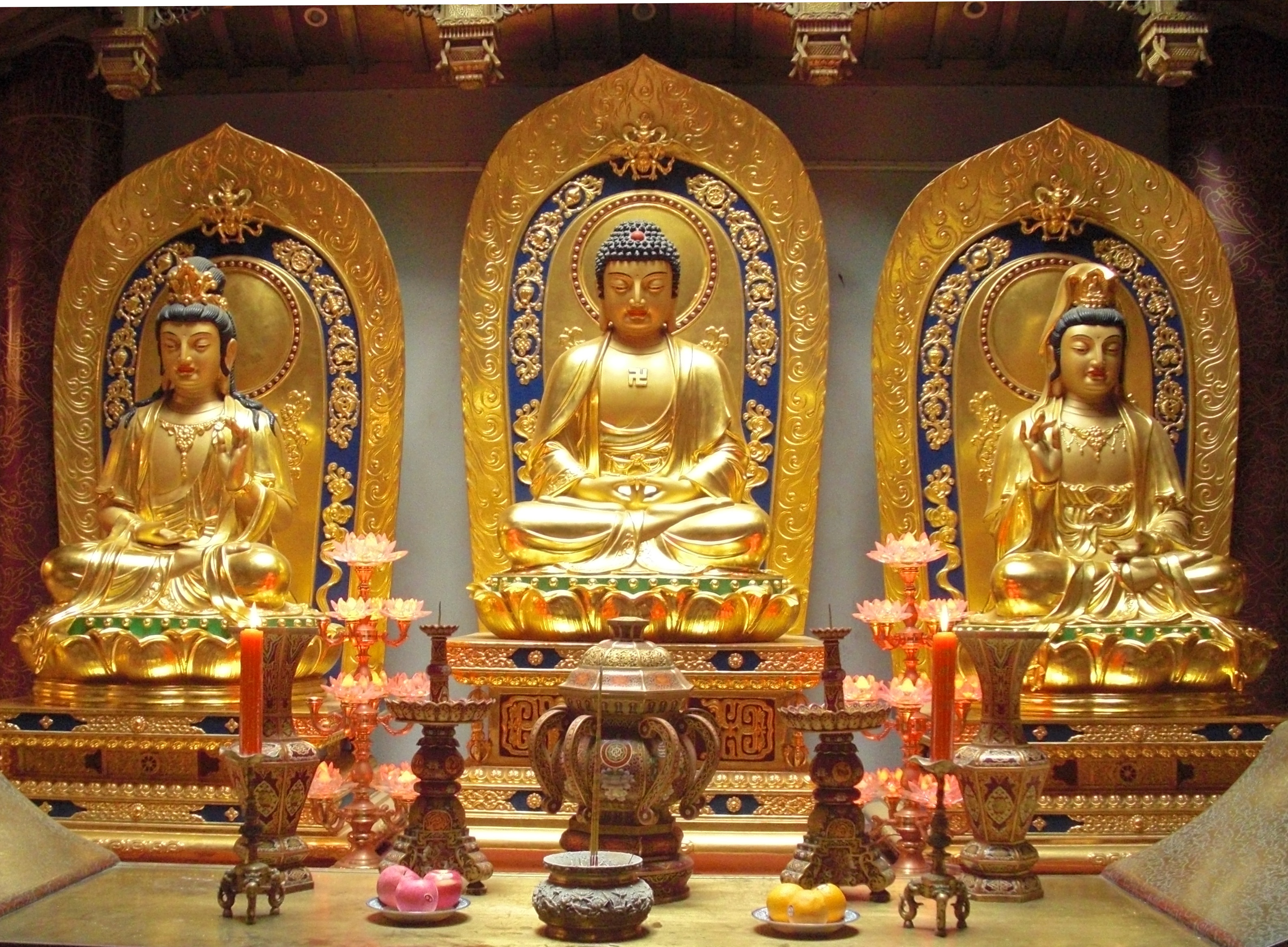|
Mappō
The Three Ages of Buddhism, also known as the Three Ages of the Dharma (), are three divisions of time following Shakyamuni Buddha's death and passing into Nirvana in East Asian Buddhism. Three Ages The Three Ages of Buddhism are three divisions of time following Buddha's passing: # Former Day of the Dharma — also known as the “Age of the Right Dharma” (; Japanese: shōbō), the first thousand years (or 500 years) during which the Buddha's disciples are able to uphold the Buddha's teachings; # Middle Day of the Dharma — also known as the “Age of Semblance Dharma” (; Japanese: zōhō), the second thousand years (or 500 years), which only resembles the right Dharma; # Latter Day of the Dharma — also known as “the Degenerate Age of Dharma” (; Japanese: mappō), which is to last for 10,000 years during which the Dharma declines. In the Sutra of the Great Assembly (Sanskrit: ''Maha-Samnipata Sutra''; Japanese: ''Daijuku-kyō''), the three periods are further di ... [...More Info...] [...Related Items...] OR: [Wikipedia] [Google] [Baidu] |
Nichiren Daishonin
Nichiren (16 February 1222 – 13 October 1282) was a Japanese Buddhist priest and philosopher of the Kamakura period. Nichiren declared that the Lotus Sutra alone contains the highest truth of Buddhist teachings suited for the Third Age of Buddhism, insisting that the Sovereign of Japan and its people should support only this form of Buddhism and eradicate all others. He advocated the repeated recitation of its title, ''Nam(u)-myoho-renge-kyo'' as the only path to Buddhahood and held that Shakyamuni Buddha and all other Buddhist deities were extraordinary manifestations of a particular Buddha-nature termed ''Myoho-Renge'' that is equally accessible to all. He declared that believers of the Sutra must propagate it even under persecution. Nichiren was a prolific writer and his biography, temperament, and the evolution of his beliefs has been gleaned primarily from his own writings. He claimed the reincarnation of Jōgyō bodhisattva in a past life, and designated six sen ... [...More Info...] [...Related Items...] OR: [Wikipedia] [Google] [Baidu] |
Shakyamuni Buddha
Siddhartha Gautama, most commonly referred to as the Buddha, was a wandering ascetic and religious teacher who lived in South Asia during the 6th or 5th century BCE and founded Buddhism. According to Buddhist tradition, he was born in Lumbini, in what is now Nepal, to royal parents of the Shakya clan, but renounced his home life to live as a wandering ascetic ( sa, śramaṇa). After leading a life of begging, asceticism, and meditation, he attained enlightenment at Bodh Gaya in what is now India. The Buddha thereafter wandered through the lower Indo-Gangetic Plain, teaching and building a monastic order. He taught a Middle Way between sensual indulgence and severe asceticism, leading to Nirvana, that is, freedom from ignorance, craving, rebirth, and suffering. His teachings are summarized in the Noble Eightfold Path, a training of the mind that includes meditation and instruction in Buddhist ethics such as right effort, mindfulness, and ''jhana''. He died in Kushina ... [...More Info...] [...Related Items...] OR: [Wikipedia] [Google] [Baidu] |
Dharma
Dharma (; sa, धर्म, dharma, ; pi, dhamma, italic=yes) is a key concept with multiple meanings in Indian religions, such as Hinduism, Buddhism, Jainism, Sikhism and others. Although there is no direct single-word translation for ''dharma'' in European languages, it is commonly translated as "righteousness", "merit" or "religious and moral duties" governing individual conduct.Britannica, The Editors of Encyclopaedia. (9 April 2019)Dharma. ''Encyclopedia Britannica''. Accessed 14 September 2021. In Hinduism, dharma is one of the four components of the '' Puruṣārtha'', the aims of life, and signifies behaviours that are considered to be in accord with ''Ṛta'', the order that makes life and universe possible. It includes duties, rights, laws, conduct, virtues and "right way of living".see: *"Dharma", ''The Columbia Encyclopedia'', 6th Ed. (2013), Columbia University Press, Gale, ; *Steven Rosen (2006), Essential Hinduism, Praeger, , Chapter 3. It had a transte ... [...More Info...] [...Related Items...] OR: [Wikipedia] [Google] [Baidu] |
Vajrayana
Vajrayāna ( sa, वज्रयान, "thunderbolt vehicle", "diamond vehicle", or "indestructible vehicle"), along with Mantrayāna, Guhyamantrayāna, Tantrayāna, Secret Mantra, Tantric Buddhism, and Esoteric Buddhism, are names referring to Buddhist traditions associated with Tantra and "Secret Mantra", which developed in the medieval Indian subcontinent and spread to Tibet, Nepal, other Himalayan states, East Asia, and Mongolia. Vajrayāna practices are connected to specific lineages in Buddhism, through the teachings of lineage holders. Others might generally refer to texts as the Buddhist Tantras. It includes practices that make use of mantras, dharanis, mudras, mandalas and the visualization of deities and Buddhas. Traditional Vajrayāna sources say that the tantras and the lineage of Vajrayāna were taught by Śākyamuni Buddha and other figures such as the bodhisattva Vajrapani and Padmasambhava. Contemporary historians of Buddhist studies meanwhile argue t ... [...More Info...] [...Related Items...] OR: [Wikipedia] [Google] [Baidu] |
Amitābha
Amitābha ( sa, अमिताभ, IPA: ), also known as Amitāyus, is the primary Buddha of Pure Land Buddhism. In Vajrayana Buddhism, he is known for his longevity, discernment, pure perception, purification of aggregates, and deep awareness of emptiness for each phenomenon. According to a Pure Land Buddhist scripture, he possesses infinite merit that results from good deeds over countless past lives as Dharmākara. Doctrine Attainment of Buddhahood According to the '' Larger Sūtra of Immeasurable Life'', Amitābha was, in very ancient times and possibly in another system of worlds, a monk named Dharmākara. In some versions of the sūtra, Dharmākara is described as a former king who, having come into contact with Buddhist teachings through the buddha Lokeśvararāja, renounced his throne. He then resolved to become a Buddha and to create a ' (literally "buddha-field", often called a "Pureland" or "Buddha Land": a realm existing in the primordial universe ou ... [...More Info...] [...Related Items...] OR: [Wikipedia] [Google] [Baidu] |
Pure Land
A pure land is the celestial realm of a buddha or bodhisattva in Mahayana Buddhism. The term "pure land" is particular to East Asian Buddhism () and related traditions; in Sanskrit the equivalent concept is called a buddha-field (Sanskrit ). The various traditions that focus on pure lands have been given the nomenclature Pure Land Buddhism. Pure lands are also evident in the literature and traditions of Taoism and Bon. Discussion In the Mahayana sutras, there are many pure lands. Bodhisattvas such as Avalokiteśvara and Manjushri would obtain pure lands after they attained buddhahood. In the ''Lotus Sutra'', Buddha's close followers such as Śāriputra, Mahākāśyapa, Subhuti, Maudgalyāyana and Buddha's son Rāhula would also have pure lands. The relative time-flow in the pure lands may be different, with a day in one pure land being equivalent to years in another. Pure lands have been documented as arising due to the intention and aspiration of a bodhisattva such ... [...More Info...] [...Related Items...] OR: [Wikipedia] [Google] [Baidu] |
Pure Land Buddhism
Pure Land Buddhism (; ja, 浄土仏教, translit=Jōdo bukkyō; , also referred to as Amidism in English,) is a broad branch of Mahayana Buddhism focused on achieving rebirth in a Buddha's Buddha-field or Pure Land. It is one of the most widely practiced traditions of Buddhism in East Asia. According to Charles B. Jones "Pure Land is the dominant form of Buddhism in China, Japan and Korea."Jones, Charles B. (2021). ''Pure Land: History, Tradition, and Practice'', p. xii. Shambhala Publications, . In Chinese Buddhism, the tradition is sometimes called a zōng (school) in an institutional sense, but historically it was most commonly described as a "dharma-gate" (fǎmén 法門), referring to a method of Buddhist practice. In Japanese Buddhism, the term more commonly refers to specific institutions.Jones, Charles B. (2019) ''Chinese Pure Land Buddhism, Understanding a Tradition of Practice,'' pp. 10-12. University of Hawai‘i Press / Honolulu. In Tibetan Buddhism, prayers and ... [...More Info...] [...Related Items...] OR: [Wikipedia] [Google] [Baidu] |
Buddhism In Central Asia
Buddhism in Central Asia refers to the forms of Buddhism (mainly Mahayana) that existed in Central Asia, which were historically especially prevalent along the Silk Road. The history of Buddhism in Central Asia is closely related to the Silk Road transmission of Buddhism during the first millennium of the common era. History Buddhist monastic groups A number of Early Buddhist schools were historically prevalent throughout Central Asia. A number of scholars identify three distinct major phases of missionary activities seen in the history of Buddhism in Central Asia, which are associated with the following sects (chronologically): # Dharmaguptaka # Sarvāstivāda # Mūlasarvāstivāda The Dharmaguptaka made more efforts than any other sect to spread Buddhism outside India, to areas such as Afghanistan, Central Asia, and China, and they had great success in doing so. Therefore, most countries which adopted Buddhism from China, also adopted the Dharmaguptaka vinaya and ordinati ... [...More Info...] [...Related Items...] OR: [Wikipedia] [Google] [Baidu] |
Sanjiejiao
The Sanjiejiao ( "Three degrees religion") or Pufazong ( "Popular faith religion") was a religious movement based on the teachings of the Chan Buddhist monk Xinxing (, 540-594). Teachings Xinxing taught that in the last of the Three Ages of Buddhism, Buddhists must learn all the Buddhist teachings. He taught tapas (ascetic practices), begging for food, eating only one meal daily, worshiping all living things as Buddhas based on the doctrine of the Buddha-nature, building public charity "treasure houses" () for monastics and laypeople alike, and sky burial upon death. History Based in Hua Du monastery (化度寺) in Chang'an, the movement was very popular in 600-700 CE. The monks lived in the Sanjiejiao house, or Sanjieyuan (三階院) inside Buddhist monasteries and built endless treasure houses. Its practices faced heavy criticism from many Buddhists and restriction by Buddhist Emperor Wen of Sui and Wu Zetian as unorthodox teachings. Emperor Xuanzong of Tang ordered the destructi ... [...More Info...] [...Related Items...] OR: [Wikipedia] [Google] [Baidu] |
Nanyue Huisi
Nanyue Huisi (, 515-577), was an eminent Chinese Buddhist monk, traditionally regarded as the third patriarch of the Tiantai school. According to Sasaki, Huisi "was the leading authority on the ''Lotus Sutra'' of his time." Biography The earliest sources on Huisi's life are the "Vow Established by the Great Dhyana Master Huisi from Southern Peak", a work attributed to Huisi, Daoxuan´s hagiography in the "Continued Biographies of Eminent Monks" (續高僧傳 Xù gāosēng zhuàn) and in his "Catalogue of uddhistWorks in the Imperial Collection of the Great Tang". Born with the surname Li () in Wujin 武津 (Shangcai 上蔡, Henan 河南) in 515 CE, Huisi left home to join the monastic order at fourteen. By the age of nineteen, he undertook the full monastic precepts, thus becoming a fully ordained monk. Then he began visiting meditation masters in northern Henan. He joined the community of Huiwen, who, according to Tiantai tradition, taught meditation techniques of the G ... [...More Info...] [...Related Items...] OR: [Wikipedia] [Google] [Baidu] |
Vinaya Pitaka
The Vinaya (Pali & Sanskrit: विनय) is the division of the Buddhist canon ('' Tripitaka'') containing the rules and procedures that govern the Buddhist Sangha (community of like-minded ''sramanas''). Three parallel Vinaya traditions remain in use by modern ''sanghas'': the Theravada (Sri Lanka & Southeast Asia), Mulasarvastivada (Tibetan Buddhism and the Himalayan region) and Dharmaguptaka ( East Asian Buddhism). In addition to these Vinaya traditions, Vinaya texts of several extinct schools of Indian Buddhism are preserved in the Tibetan and East Asian canons, including those of the Kāśyapīya, the Mahāsāṃghika, the Mahīśāsaka, and the Sarvāstivāda The word ''Vinaya'' is derived from a Sanskrit verb that can mean to lead, take away, train, tame, or guide, or alternately to educate or teach. It is often translated as 'discipline', with ''Dhamma-vinaya'', 'doctrine and discipline', used by the Buddha to refer to his complete teachings, suggesting its integ ... [...More Info...] [...Related Items...] OR: [Wikipedia] [Google] [Baidu] |

.jpg)

_(8697431158).jpg)

.jpg)

